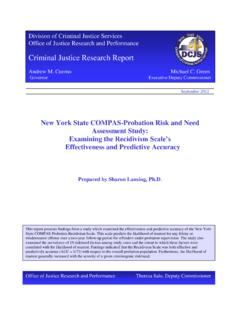Transcription of COMPAS Risk & Need Assessment System
1 Copyright 2012 Northpointe Inc., its subsidiaries and affiliates. All rights reserved. COMPAS Risk & Need Assessment System Selected Questions Posed by Inquiri ng Agencies Ease of Use Does your tool require an interview with the inmate? If so, what advantage does this offer? Northpointe designed COMPAS to allow for test administration flexibility. There are several options data gathering options, any of which are valid . The offender may fill out the self-- report section on his or her own. There may be a sc ripted interview, in which questions are asked verbatim. The interviewer may use a guided discussion format to si multaneously gather the Assessment data and enhance rapport and buy-- in for the intervention process, using a motivational interviewing style.
2 The choice is the agency s to make, depending on the skill level of their staff, the time available to collect the data, and the resources available for COMPAS administration. Does COMPAS rely on static factors (criminal history only)? How does this approach compare to the static plus dynamic measurement approach employees by other companies? COMPAS relies on both st atic and dynamic data to generate its risk and needs results. The use of dynamic measures allo ws for measures to change over time as behavior changes. These changes are included in the measures of risk and need.
3 The dynamic factors also allo ws for the overlay of previous assessments on the latest Assessment to vi sual see any change in risk and need scores. Is there a short-- screen/pre-- screen? COMPAS is scalable to fit the needs of many diff erent decisi on points, including pre-- screening. In applyi ng the risk principle, many agencies select the Violence and Recidivi sm risk scales for pre-- screening or tri aging the case. Individuals that score higher on risk may then have a more in-- depth Assessment using additional COMPAS scales. Information previously entered into a COMPAS Assessment is automatically imported into the second tier Assessment .
4 This also allo ws for the distribution of the Assessment workload over several offender processing points pre-- tri al might turn just the scales needed to support a release decisi on then at post sentence, for example, additional scales would be added to their Assessment in support of supervisi on and treatment decisions (case plan). How long does it take to administer the tool? This depends on the Assessment information needs at a parti cular offender processing point and the scales that you have determined are necessary to inform a decisi on. COMPAS Assessment can take anywhere fr om 10 minutes to an hour depending on the scale content and administr ation data collection st yle.
5 When possible, we also encourage developing an interface between COMPAS and other MIS systems. These System interfaces are built quickly and are designed to eliminate redundant data entry. Copyright 2012 Northpointe Inc., its subsidiaries and affiliates. All rights reserved. Accuracy and Utility What is the theoretical framework for this tool? COMPAS incorporates a comprehensive theory-- based Assessment approach. It is designed to incorporate key scales from several of the most informative theoretical explanations of crime and delinquency including General Theory of Crime, Criminal Opportunity/Lifestyle Theories, Social Learning Theory, Subculture Theory, Social Control Theory, Criminal Opportunities/Routine Activiti es Theory and Strain Theory.
6 On what population was the risk tool normed ? COMPAS offers several norm group options at sy stem configuration including community corrections, jail populations, prison inmates, and a composite norming group representing all of the above. Each agency, with guidance from Northpointe, decides which norm group(s) they wish to score the Assessment against. In addition, COMPAS is normed to male and female populations as well. As suffici ent data become available, the Northpointe R&D team can work with the sit e to design samples that will generate locally relevant norms.
7 Has your tool been evaluated by an independent source? COMPAS psy chometri c data has been peer-- reviewed and published in a number of professional journals including Criminal Justice and Behavior January 2009 and Journal of Quantit ative Criminology June 2008. COMPAS psychometri c reports are available from Northpointe upon request. Is COMPAS valid? The General Recidivism Risk scale was developed in a sa mple of presentence investi gation (PSI) and probation intake cases. The outcome was any arrest (misdemeanor or felony) within two years of the intake Assessment .
8 We recently validated the General Recidivism Risk scale in a sample of 2,328 PSI and probation intake cases. We fi t survival models in which the Recidivism Risk scale predicted any offense, person offenses, and felony offenses. The AUCs ranged from .68 to .71 in the full sample. The follo w-- up time ranged from about one year to four years (Brennan, Dietrich, & Egret, 2009). These predicti ve results meet or exceed results for other si mila r assessments . The Violent Recidivism Scale was developed using survival modeling in a sample of probation intake and PSI cases to predict person offenses.
9 The follow-- up times ranged from one year to four years. We have evidence of the predicti ve valid ity of the Violent Recidivism Risk scale for person offenses in New York Parole reentry pilo t [2008] (n=800, AUC=.73, survival follow-- up = 2 years) and New York Probation study [2009] (n=5,889, AUC= .72, survival follow-- up=2 years). These predictive results meet or exceed results for other similar assessments . Copyright 2012 Northpointe Inc., its subsidiaries and affiliates. All rights reserved. We have evidence of predicti ve validity of the Violent Recidivism Risk scale for return to prison for felony person nontechnical violations [2007] (n=20,898, AUC=.)
10 67, survival follow-- up time=1 year). There is good evidence from these studies that the risk scales predict recidivi sm outcomes that occur between one and two years from Assessment (probation intake, PSI, reentry). How well does it predict violence? In the most recent outcomes st udy conducted on the COMPAS Risk of Violence scale on a New York parole population 2009 AUC s were .73. This is consistent with other outcomes studies we have conducted and meets or exceeds AUC s from other Assessment tools. Does the tool work well with all populations (female, mentally disordered, different races, etc.









